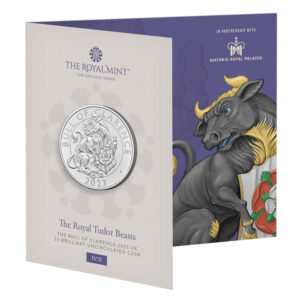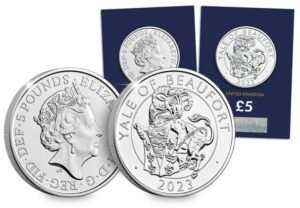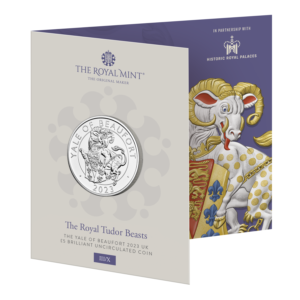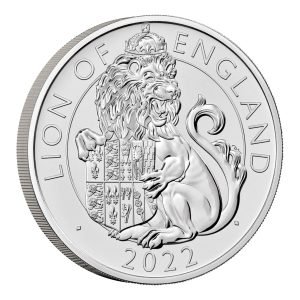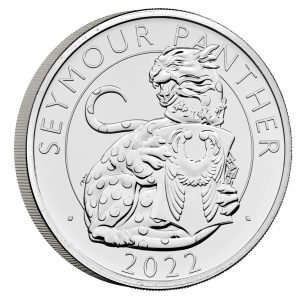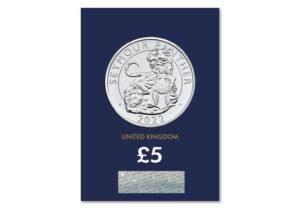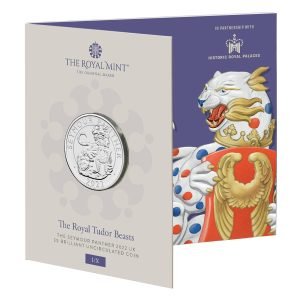
When the House of Lancaster overcame the House of York following the Wars of the Roses, a formidable dynasty was born. Henry VII, following his matrimonial union with Elizabeth of York to unite the houses, was keen to emphasise the legitimacy of his reign. He looked to the medieval tradition of heraldry to display motifs and symbols wherever possible, reinforcing his rightful position on the English throne to his subjects as well as rival claimants.
Henry VIII continued his father’s commitment to legitimising the Tudor dynasty. One such place that heavily features heraldic symbols is Hampton Court Palace – one of the king’s most famous residences and a place he used for pleasure and celebration.
Ten stone beasts line the Moat Bridge, representing the lineage of Henry VIII and his third wife, Jane Seymour. Consisting of real beasts and mythical creatures, we are honouring these heraldic symbols of one of the nation’s most powerful dynasties with The Royal Tudor Beasts Collection.
06 Tudor Dragon
Tudor Dragon was adopted by the Tudor family to celebrate their royal Welsh heritage. The Tudor Dragon is the last King’s Beast that visitors pass along the Moat Bridge as they enter Hampton Court Palace.
-
Product on sale2024 Royal Tudor Beasts 06 Tudor Dragon 1 Oz Silver ProofOriginal price was: £103.50.£97.50Current price is: £97.50.
-
Product on sale2024 Royal Tudor Beasts 06 Tudor Dragon £5 BUOriginal price was: £15.50.£15.00Current price is: £15.00.
05 Seymour Unicorn
The Seymour Unicorn follows the Bull of Clarence onto the latest coin in the collection. Before being chosen by Henry VIII to guard the Moat Bridge, the mythical unicorn wasn’t really known as a royal heraldic beast. Wild and untamed, the unicorn was believed to be the strongest of all creatures, so to have one set in stone outside the palace was a clear display of royal dominance. Many believed the unicorn also represented purity and fertility, and so by giving the beast to Jane Seymour, the king was perhaps hoping their marriage would be blessed with a son and heir.
-
Product on sale2024 Royal Tudor Beasts 05 Seymour Unicorn 1 Oz Silver ProofOriginal price was: £102.50.£95.00Current price is: £95.00.
-
Product on sale2024 Royal Tudor Beasts 05 Seymour Unicorn £5 BUOriginal price was: £15.50.£14.50Current price is: £14.50.
04 Bull of Clarence
Known for its representation of strength, power, and wealth, the bull is one of the oldest animal symbols in the world. The heraldic Bull of Clarence joins the King’s Beasts on the Moat Bridge to reinforce Henry VIII’s ancestral links to the Yorkist dynasty.
-
2023 Royal Tudor Beasts 04 Bull of Clarence £5 BU Coin in Capsule£13.00
-
Product on sale2023 Royal Tudor Beasts 04 Bull of Clarence 1 Oz Silver ProofOriginal price was: £102.50.£95.00Current price is: £95.00.
-
Product on sale2023 Royal Tudor Beasts 04 Bull of Clarence £5 BUOriginal price was: £15.50.£14.50Current price is: £14.50.
03 Yale of Beaufort
Yale of Beaufort is a beast that is so extraordinary it would have inspired awe in all who approached the palace, due to its antelope-like body, lion’s tail, and tusks of a boar. The peculiar beast was closely associated with the powerful Beaufort family, and the Yale of Beaufort on the Moat Bridge was presented holding the Arms of Jane Seymour to reinforce her authority and influence as the king’s new wife.
02 The Lion of England
The Lion of England is one of the oldest and most iconic beasts in heraldry. It first appeared on royal emblems in the twelfth century and has been part of the shield of England for as long as it has existed. Chosen to represent pride and courage, the Lion of England on the Moat Bridge at Hampton Court Palace holds a shield bearing the impaled – or combined – arms of Henry VIII and Jane Seymour, symbolising the strength of the couple’s union.
01 The Seymour Panther
The Seymour Panther was given to Jane Seymour, Henry VIII’s third wife, by the king from the treasury of royal beasts. Like his father before him, Henry VIII adopted the panther as a symbol to reinforce his regal lineage. The statue appears on the viewer’s left-hand side (dexter) and the coat of arms depict the Duke of Beaufort’s arms, whose family Henry VIII’s grandmother descended from. Possessing the tail of a lion and the claws of an eagle, the heraldic beast is often portrayed as angry and incensed, with fire coming from its mouth and ears.
-
2022 Royal Tudor Beasts 01 Seymour Panther £5 BU Coin in Capsule£14.00
-
Product on sale2022 Royal Tudor Beasts 01 Seymour Panther £5 CC Certified BUOriginal price was: £15.00.£13.00Current price is: £13.00.
-
2022 Royal Tudor Beasts 01 Seymour Panther £5 BU£17.00
-
2022 Royal Tudor Beasts 01 Seymour Panther 1 Oz Silver Proof£105.00






